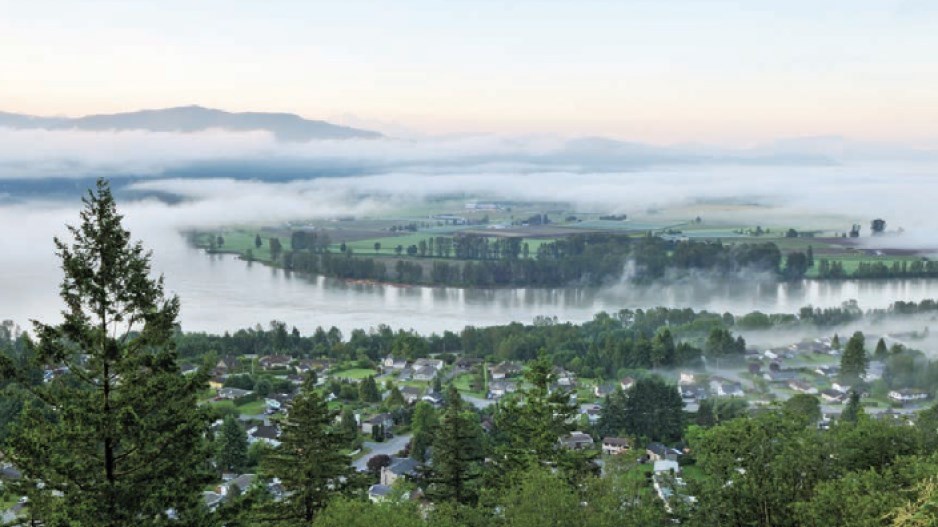Growth hurdles
Stretching southeast from the Port Mann Bridge, the Fraser Valley offers something akin to a field of dreams for developers. Project costs are typically lower, and what's built attracts good demand from buyers seeking affordable housing.
But as in much of the Lower Mainland, there's a catch: supplies of developable land are limited.
True, densification is making better use of available land. Scott Brown, president of Fifth Avenue Real Estate Marketing Ltd., recently told an Urban Development Institute meeting in Surrey that townhomes are “the ‘new' single-family home for this generation.”
But a limited supply of developable acreage means prices for new homes aren't rising quite as fast as that of the land they're built on, according to Justin Mitchell, co-owner of Frontline Real Estate Services Ltd. in Surrey.
“There's a fairly strong demand curve and limited supply of good land that doesn't have ALR [agricultural land reserve], creeks, trees and all sorts of other issues that impede development,” Mitchell said.
“The supply of available raw development land is not as vast as people would think in the suburbs where we would expect to see most of the growth.”
Provincial standards for the Vedder River in Chilliwack, for example, define a one-in-200-year flood plain, while in Langley and elsewhere, just 25% of land lies outside the ALR.
The demand for land is backed up by RealNet Canada Inc., which recently reported “sustained quarter-over-quarter growth in capital flows” into land purchases.
Residential land in particular had its second-best quarter on record in the first three months of 2014.
All told, lands valued at $828.8 million changed hands in the quarter – and 56% of all transactions in Greater Vancouver were worth more than $1 million.
Staggering strength
The latest issue of the B.C. Major Projects Inventory logs the status of a stunning $311.8 billion worth of projects. Digging into those numbers, one discovers intriguing trends.
For example, the number of major projects proposed in B.C. has increased marginally since the recession, from 445 in September 2008 to 471 in March 2014. But the total value of those proposals has nearly doubled, from $100.1 billion to $200 billion.
“This may well be the era of the megaproject driving B.C.'s economy,” said Bryan Yu, regional economist with Central 1 Credit Union, in his weekly economic briefing.
The increase has happened despite what Yu calls “a slow-growth economy” – a phenomenon reflected in the 78 projects on hold.
While projects on hold have declined from a peak of 87 in March 2013, they're still more than double the 32 logged in March 2008. The value of those projects is $20.4 billion, not quite double the tally of $10.9 billion sitting on the shelf in March 2008.
“We're seeing certain sectors rise in terms of the numbers on hold because of poor economic conditions,” Yu said, citing mining as one example. “But it's being offset at some level by the new flow of projects that are being proposed. ... As long as those continue to go up, it's still generally positive for the future.”
Yu believes the growing value of proposed projects bodes well for the strength of B.C.'s economy in the medium to long term.
Some good news
Yes, housing in Vancouver is expensive – by some measures, the second-least affordable in the world. And no, wage growth hasn't helped matters; median weekly wages in B.C. lag behind national wages more often than not.
But the good news is that increases in shelter costs in Vancouver (not to mention B.C. as a whole) have been far less than for Canada as a whole, according to Statistics Canada.
Twenty years ago, between the housing boom and recession that bookended the 1990s in B.C., shelter costs in Vancouver stood at 100.2 versus a baseline of 2002. Within five years, in July 1999, tough economic times had depressed indexed shelter costs to 95.4.
Costs in B.C. as a whole were a smidgen higher, but shelter costs across Canada in July 1994 and July 1999 stood at 89.2 and 92.1, respectively.
But since 2002, appreciation in shelter costs nationally has outstripped that in B.C.
The latest figures, for May 2014, peg shelter costs in Vancouver at 18.1% above 2002, while in B.C. as a whole they're 14.6% more.
And nationwide? Shelter costs are a stunning 32.6% more than in 2002 – a shift that would make circumstances dire indeed were that kind of increase experienced here. •




